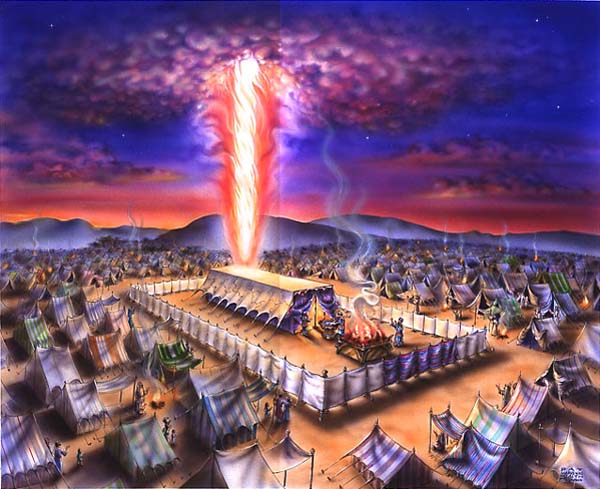
Words Of Gratitude
A period of about half a year was occupied in the building of the tabernacle. When it was completed, Moses examined all the work of the builders, comparing it with the pattern shown him in the mount and the directions he had received from God. "As the Lord had commanded, even so had they done it: and Moses blessed them." With eager interest the multitudes of Israel crowded around to look upon the sacred structure. While they were contemplating the scene with reverent satisfaction, the pillar of cloud floated over the sanctuary and, descending, enveloped it. "And the glory of the Lord filled the tabernacle." There was a revealing of the divine majesty, and for a time even Moses could not enter. With deep emotion the people beheld the token that the work of their hands was accepted. There were no loud demonstrations of rejoicing. A solemn awe rested upon all. But the gladness of their hearts welled up in tears of joy, and they murmured low, earnest words of gratitude that God had condescended to abide with them.
By divine direction the tribe of Levi was set apart for the service of the sanctuary. In the earliest times every man was the priest of his own household. In the days of Abraham the priesthood was regarded as the birthright of the eldest son. Now, instead of the first-born of all Israel, the Lord accepted the tribe of Levi for the work of the sanctuary. By this signal honor He manifested His approval of their fidelity, both in adhering to His service and in executing His judgments when Israel apostatized in the worship of the golden calf. The priesthood, however, was restricted to the family of Aaron. Aaron and his sons alone were permitted to minister before the Lord; the rest of the tribe were entrusted with the charge of the tabernacle and its furniture, and they were to attend upon the priests in their ministration, but they were not to sacrifice, to burn incense, or to see the holy things till they were covered.
In accordance with their office, a special dress was appointed for the priests. "Thou shalt make holy garments for Aaron thy brother, for glory and for beauty," was the divine direction to Moses. The robe of the common priest was of white linen, and woven in one piece. It extended nearly to the feet and was confined about the waist by a white linen girdle embroidered in blue, purple, and red. A linen turban, or miter, completed his outer costume. Moses at the burning bush was directed to put off his sandals, for the ground whereon he stood was holy. So the priests were not to enter the sanctuary with shoes upon their feet. Particles of dust cleaving to them would desecrate the holy place. They were to leave their shoes in the court before entering the sanctuary, and also to wash both their hands and their feet before ministering in the tabernacle or at the altar of burnt offering. Thus was constantly taught the lesson that all defilement must be put away from those who would approach into the presence of God.
The garments of the high priest were of costly material and beautiful workmanship, befitting his exalted station. In addition to the linen dress of the common priest, he wore a robe of blue, also woven in one piece. Around the skirt it was ornamented with golden bells, and pomegranates of blue, purple, and scarlet. Outside of this was the ephod, a shorter garment of gold, blue, purple, scarlet, and white. It was confined by a girdle of the same colors, beautifully wrought. The ephod was sleeveless, and on its gold-embroidered shoulder pieces were set two onyx stones, bearing the names of the twelve tribes of Israel.
Over the ephod was the breastplate, the most sacred of the priestly vestments. This was of the same material as the ephod. It was in the form of a square, measuring a span, and was suspended from the shoulders by a cord of blue from golden rings. The border was formed of a variety of precious stones, the same that form the twelve foundations of the City of God. Within the border were twelve stones set in gold, arranged in rows of four, and, like those in the shoulder pieces, engraved with the names of the tribes. The Lord's direction was, "Aaron shall bear the names of the children of Israel in the breastplate of judgment upon his heart, when he goeth in unto the holy place, for a memorial before the Lord continually." Exodus 28:29. So Christ, the great High Priest, pleading His blood before the Father in the sinner's behalf, bears upon His heart the name of every repentant, believing soul. Says the psalmist, "I am poor and needy; yet the Lord thinketh upon me." Psalm 40:17.
At the right and left of the breastplate were two large stones of great brilliancy. These were known as the Urim and Thummim. By them the will of God was made known through the high priest. When questions were brought for decision before the Lord, a halo of light encircling the precious stone at the right was a token of the divine consent or approval, while a cloud shadowing the stone at the left was an evidence of denial or disapprobation.
The miter of the high priest consisted of the white linen turban, having attached to it by a lace of blue, a gold plate bearing the inscription, "Holiness to Jehovah." Everything connected with the apparel and deportment of the priests was to be such as to impress the beholder with a sense of the holiness of God, the sacredness of His worship, and the purity required of those who came into His presence.
PP 349-351